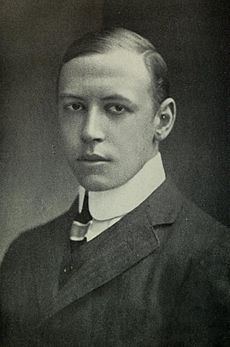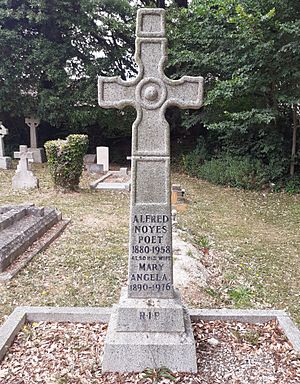Alfred Noyes facts for kids
Quick facts for kids
Alfred Noyes
|
|
|---|---|

Portrait of Alfred Noyes, by Alexader Bassano, 1922
|
|
| Born | 16 September 1880 Wolverhampton, England |
| Died | 25 June 1958 (aged 77) Isle of Wight, England |
| Resting place | Totland |
| Occupation | Poet |
| Alma mater | Exeter College, Oxford |
| Period | 1902–1958 |
| Subject | English |
| Notable works | "The Highwayman" "The Barrel-Organ" |
| Notable awards | D.Litt., Yale University, 1913 CBE, 1918 |
| Spouse | Garnett Daniels (1907–1926) Mary Angela Mayne (1927–1958) |
| Children | Hugh Veronica Margaret |
|
|
|
Alfred Noyes CBE (born September 16, 1880 – died June 25, 1958) was an English poet, short-story writer, and playwright. He is best known for his famous poems like "The Highwayman" and "The Barrel-Organ."
Contents
Early Life and Education
Alfred Noyes was born in Wolverhampton, England. When he was four years old, his family moved to Aberystwyth, Wales. His father taught Latin and Greek there. The beautiful Welsh coast and mountains greatly inspired young Alfred.
In 1898, Noyes went to Exeter College, Oxford. He was very good at rowing. However, he did not finish his degree. On the day of his final exams in 1903, he was meeting with a publisher. He was arranging to publish his first book of poems, The Loom of Years.
Becoming a Writer
Alfred Noyes published several more poetry books between 1903 and 1913. These included The Flower of Old Japan (1903) and Poems (1904). His poem "The Barrel-Organ" was in Poems.
Famous Poems: "The Highwayman"
His most famous poem, "The Highwayman", first appeared in Blackwood's Magazine in August 1906. It was later included in his book Forty Singing Seamen and Other Poems. In 1995, a poll by the BBC found "The Highwayman" to be Britain's 15th favorite poem.
Epic Poem: Drake
Noyes also wrote a long epic poem called Drake. This 200-page poem was about the famous Elizabethan naval commander Sir Francis Drake. It was published in two parts in 1906 and 1908. The poem was written in blank verse, which is poetry without rhyme.
Play: Sherwood
In 1911, Noyes published his only full-length play, Sherwood. It was later updated and re-released in 1926 as Robin Hood. One of his popular poems, "A Song of Sherwood", also came out in 1911.
Life in America
In 1907, Noyes married Garnett Daniels. She was the daughter of a US Army Colonel. Noyes first visited America in 1913. He gave talks about world peace and disarmament. His lectures were very popular.
He visited many American universities. In 1914, he was invited to teach at Princeton University. For the next nine years, he and his wife split their time between England and the US. Some of his students at Princeton included famous writers like F. Scott Fitzgerald. He stopped teaching in 1923 but continued to travel and lecture in the United States. His wife, Garnett, passed away in 1926 in France.
World Wars and Peace
Alfred Noyes was a pacifist, meaning he disliked war. However, he believed a nation had to fight if attacked by a dangerous enemy. He was against the Boer War but supported the Allies in both World War I and World War II.
In 1913, before World War I, he wrote a long anti-war poem called The Wine Press. It showed the terrible side of war. During World War I, Noyes could not fight because of his eyesight. Instead, he worked for the Foreign Office on propaganda. He also wrote patriotic stories and poems to boost morale.
One of his most famous anti-war poems is "The Victory Ball". He wrote it after seeing a dance in London after World War I ended. He wondered what the ghosts of dead soldiers would think of the carefree dancers. The poem's message is that "Under the dancing feet are the graves."
During World War II, Noyes wrote more patriotic poems. He also wrote a science fiction novel called The Last Man (1940). This book showed a global conflict that almost wiped out humanity.
Later Life and Works
In 1918, Noyes published a collection of short stories called Walking Shadows. Another collection, The Hidden Player, came out in 1924.
For the 1924 British Empire Exhibition, Noyes wrote poems for a musical work called Pageant of Empire. Sir Edward Elgar set these poems to music.
In 1927, Noyes married Mary Angela Mayne. Later that year, he became a Catholic. He wrote about his journey to faith in his book The Unknown God (1934). This book was very popular and helped many people understand Christian faith.
The Torch-Bearers Trilogy
Noyes wrote a huge three-part poem series called The Torch-Bearers. It was about the history of science.
- Watchers of the Sky (1922)
- The Book of Earth (1925)
- The Last Voyage (1930)
Watchers of the Sky
The first part, Watchers of the Sky, was inspired by a visit to the Mount Wilson Observatory in 1917. Noyes described the powerful reflecting telescope there. This volume tells the stories of famous astronomers like Nicolaus Copernicus, Galileo Galilei, and Isaac Newton. It shows the human side of their discoveries.
The Book of Earth
The Book of Earth is the second part. It explores discoveries about the Earth, life forms, and human origins. It features scientists from ancient Greece to modern times, including Aristotle, Leonardo da Vinci, and Charles Darwin.
The Last Voyage
The final part, The Last Voyage, has a more serious and religious tone. It was influenced by the death of Noyes' first wife and his conversion to Catholicism. The poem begins on an ocean liner during a storm. A sick little girl needs help. The story shows how all scientific discoveries can come together to save a life. However, it also explores how science cannot defeat death forever. The "last voyage" refers to everyone's journey through life and death.
The Last Man Novel
In 1940, Noyes published his science fiction novel, The Last Man (also called No Other Man). In this story, a powerful death ray almost wipes out all humans. Only a few survivors remain, hidden deep underground or underwater. The story follows an Englishman named Mark Adams as he searches for other survivors. He finds an American girl named Evelyn Hamilton. This novel is thought to have influenced George Orwell's famous book Nineteen Eighty-Four.
Later Years and Children's Books
In 1940, Noyes returned to North America. He gave lectures supporting Britain during the war. He also wrote The Edge of the Abyss (1942), which discussed the future of the world and the importance of good and evil.
In 1943, he wrote a children's story called The Secret of Pooduck Island. It was about a family of squirrels and a teenage boy who helps them.
Noyes returned to his home on the Isle of Wight in 1949. As he became more blind, he dictated his later works. In 1952, he published another children's book, Daddy Fell into the Pond and Other Poems. The title poem is still a favorite among children today.
His last book of poetry, A Letter to Lucian and Other Poems, came out in 1956.
The Accusing Ghost
In 1957, Noyes published his last book, The Accusing Ghost, or Justice for Casement. This book was about Roger Casement, a human rights activist who was hanged in 1916. British authorities used parts of Casement's private diaries to stop people from asking for him to be pardoned. Noyes had seen these diary parts and believed they were real.
Years later, people questioned if the diaries were fake. The poet W. B. Yeats even wrote a poem that mentioned Noyes, asking him to support the truth. Noyes then wrote a letter explaining his earlier belief and called for an investigation. In his 1957 book, Noyes argued that Casement had been a victim of a plot. In 2002, a study confirmed the diaries were real.
Death
Alfred Noyes wrote his last poem, Ballade of the Breaking Shell, in May 1958. He passed away a month later at the age of 77. He is buried in the Roman Catholic cemetery in Totland, Isle of Wight.
Works
Poetry
- The Loom of Years (1902)
- The Flower of Old Japan (1903)
- The Forest of Wild Thyme (1905)
- The Highwayman (1906)
- Drake (1906–08)
- Forty Singing Seamen and Other Poems (1907)
- The Golden Hynde (1908)
- Tales of the Mermaid Tavern (1913)
- Watchers of the Sky (1922)
- The Book of Earth (1925)
- The Last Voyage (1930)
- Shadows on the Down (1941)
- Collected Poems (1950)
- Daddy Fell into the Pond (1952)
- A Letter to Lucian (1956)
Other Works
- The Thames in Literature (1907)
- William Morris (1908) Biography.
- Rada (1914) Drama.
- Walking Shadows (1918) Short Stories.
- The Hidden Player (1924) Short Stories.
- Some Aspects of Modern Poetry (1924) Criticism.
- The Opalescent Parrot (1929) Criticism.
- The Return of the Scare-Crow (1929) Novel.
- The Unknown God (1934) Autobiography.
- Orchard's Bay (1936) Essays.
- Voltaire (1936) Biography.
- The Last Man (1940) Novel.
- Pageant of Letters (1940) Criticism.
- The Secret of Pooduck Island (1943) Children's story.
- Two Worlds for Memory (1953) Autobiography.
- The Devil Takes A Holiday (1955) Novel.
- The Accusing Ghost (1957)
Films Based on Noyes' Works
- Dick Turpin's Ride
Songs Based on Noyes' Works
- Eight songs set by to music by Elgar in the 1924 Pageant of Empire
- Bacchus and the Pirates (Michael Brough)
- Everywhere (1987 music video by Fleetwood Mac)
- Madrigals Book XI Carmina Silvicola (Clive Strutt)
- The Highwayman by Phil Ochs
- Let My Love Be Heard by Jake Runestad, setting of Noyes’ A Prayer
- The Highwayman by Loreena McKennitt
Images for kids
See also
 In Spanish: Alfred Noyes para niños
In Spanish: Alfred Noyes para niños






